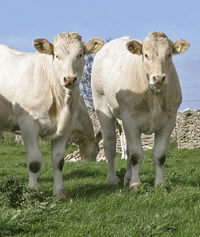South east launches all-inclusive health scheme for cattle

Cattle farmers in the south east will soon have the opportunity to become involved in a revolutionary animal health initiative aimed at improving the health and, hopefully, value of all animals in the region.
Livestock Accreditation South East Region (LASER) will be an all-inclusive scheme with all farmers who are clients of a participating vet practice automatically becoming members, unless they specifically opt out.
The scheme, run by the Animal Health and Welfare sub-group of the south east’s Sustainable Food and Farming Strategy group will encourage farmers to identify and understand the health status of stock on their farm and offer accreditation for diseases of economic importance, explains one of its originators, Matt Dobbs of Westpoint Vet Group.
“Farms will be given different levels of certification depending on their disease status for a range of conditions, with grading running from bronze for the poorest through to platinum for the best. Additionally, farms will be able to enter into an ongoing farm health programme with regular vet reviews.”
But while at first glance LASER may appear to be repeating the work already done by other health schemes, its intention is to link into exisiting national schemes, such as SAC and Biobest. “Members of these other schemes will benefit from LASER as it will allow them increased recognition of their efforts.”
Under the scheme farms will be assessed by their own vet and certified for a number of diseases, including bovine viral diahorrea (BVD), infectious bovine rhinotracteitis (IBR), leptospirosis, Johne’s and bovine TB. “As progress is made in controlling or eradicating these diseases from herds the farm will gradually move up the status scale.”
This approach should bring improved disease management and control and lead to increased economic performance, allowing farmers to achieve premiums when selling stock and hopefully, due to their geographical location, improved access to export markets, adds Mr Dobbs.
With most vet practices in the south east backing the scheme, the plan is for assessments to be conducted either alongside routine vet visits or, when required as separate visits. And, crucially, grading will be done on an individual disease basis, with bronze representing herds where the diseases present or of an unknown status, silver a herd where some disease control is in place, gold a unit which is managing or working to eradicate the disease and platinum awared when stock are accredited free of disease.
“So, taking BVD as an example, when a herd has disease present and has partial, lapsed or no vaccination ongoing they will be classified as bronze. To gain silver status the herd would have to be vaccinated annually, while gold classification would require the herd to gain vaccinated and monitored free status. Platinum status, meanwhile, would signify the herd as accredited free of disease,” explains Mr Dobbs.
However, while some may question the demand for such a scheme, a survey undertaken this summer of Surrey farmer Angus Stovold reveals an overwhelming potential uptake for such a regional health scheme.
“Of the beef farmers surveyed more than 40% didn’t have a health plan, but more than 80% claimed to know their herd’s health status. But, 82% said they would join a regional health scheme.”
Despite this, though there appears to be a worrying lack of understanding from many farmers on several key issues, explains Mr Stovold. “More than 55% of those questioned said they had closed herds, yet 80% bought stock in and 15% of these didn’t isolate new stock when they arrived and more than 60% didn’t blood test new stock.
“It’s impossible to have a truly closed herd and still buy stock in and when buying stock in quarantining them is essential to prevent ingression of novel diseases.”
Among dairy farmers 90% thought a health scheme would be beneficial, but yet only 85% said they would join one, reports Mr Stovold.
CAP: The launch of a health scheme for cattle farmers in the south east should allow farmers to mazimise both the productivity and value of their stock.
